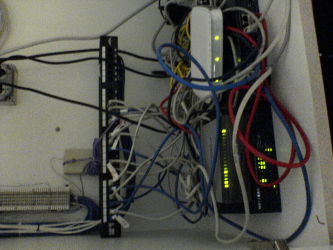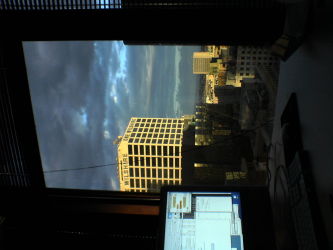Archives for March 2006
su: who are you?
March 31, 2006 by Eric Richardson
I'm still getting the NAT stuff set up on the xserve, and haven't even touched traffic shaping yet, but I was pretty amazed by how I managed to break things in the process of setting up a stateful firewall on OS X.
Apparently if you forget to allow connections via localhost, OS X sort of loses it. And I mean this to the extent that when logged in as admin, you no longer have an identity. su asks you who you are.
I guess I hadn't considered the ramifications of directory authentication, even when you're not doing remote stuff.
atprintd likes CPUs
March 31, 2006 by Eric Richardson
Here at the office we have a dual 2.3gig G5 XServe 1U as sort of the office file server. It's a shame, really, because literally all it's been doing has been just that: acting as network storage.
I've gotten fed up with the crappy little Netgear router that's running NAT, so I'm finally going to give the Xserve a little more responsibility and let it do NAT, DHCP and some traffic shaping.
The one thing that scares me a little, though, is that the server also has a couple printers connected to it and these seem to give it some periodic stability issues. For instance, I ssh'ed in just now, ran top and saw:
PID COMMAND %CPU TIME #TH #PRTS
82 atprintd 54.4% 120 hrs 1 15
81 atprintd 54.2% 120 hrs 1 15
80 atprintd 53.3% 120 hrs 1 15
So basically a dual-G5 is sitting at a load average of 3 running printer spools. Yuck. Googling for atprintd doesn't give me a whole lot on where to look for this one.
CUPS on Apple has in my experience been no more fun than CUPS on Linux. There I ditched CUPS for lprng.
Cable Management
March 23, 2006 by Eric Richardson
From the network cabinet at the office. Before...
The Office Isn't Cold, But...
March 23, 2006 by Eric Richardson
I just dropped back by work to take care of a few things and filled up a Coke bottle with water from the water cooler. I set it down by my computer and a couple minutes later went to take a sip only to find ice floating in it. It's not possible for it to come out of the cooler as ice, so the only explanation is that it came out so cold that it froze sitting in the bottle. Weird.
Fun With Disappearing Daemons
March 23, 2006 by Eric Richardson
Apparently I didn't heed the warning at the bottom of the configuration page for the NTP pool that mentioned a bug with RHEL's ntpd. My score suffered greatly when ntpd disappeared around midnight.
The SRPM linked in the bugzilla post wouldn't compile cleanly for me, so I'm now running a self-compiled ntpd. Hopefully that'll stay up and happy.
Looking at Highway Ramps
March 22, 2006 by Eric Richardson
 This evening I set out to write a blog post on how different online mapping applications draw highway ramps. It turned into something longer than a normal post, so I've put it on my regular site: Looking at Highway Ramps.
This evening I set out to write a blog post on how different online mapping applications draw highway ramps. It turned into something longer than a normal post, so I've put it on my regular site: Looking at Highway Ramps.
Like I mention in the piece, I think ramps are a really important thing to look at in a map because they're something that's really hard to do right. I know that the code I've been working on recently doesn't solve any of the problems I list, mainly because of the data I'm working with. Always remember: your output will never be any better than your data.
Mostly unrelated: I think this is the first time I've put content on ericrichardson.com in about a year. I would say the web interface of the blog has drawn me in, but the frequency (or lack thereof) of posting here might dispute that.
Setting Up a Time Server
March 22, 2006 by Eric Richardson
Reading through some local blogs this morning I noticed ask's post from a few weeks ago talking about the ntp pool. That got me inspired to set up ntp on the new Cartifact server. I knew of a couple good local time hosts (particularly chronometer.usc.edu), and going through the list of stratum two servers I found one in the very same colo building. Judging by the whois on the IP space, I think that box is in CalPop's space, which is right across the hall from our box with Cyberverse. If I'm reading the stats right, though, that box is actually the peer with the most delay.
Our server, ortelius.cartifactmaps.com, is now registered with the NTP Pool, though it'll take a little bit before the pool decides it's reliable enough to give it out to people.
Mmmm... View
March 18, 2006 by Eric Richardson
Since I got my new job, I've spent a lot of time here in the office. Some of it may be the work, but I think just as big is this view:
I love cityscapes.
Never Quite as Planned
March 15, 2006 by Eric Richardson
The replacement drive for my laptop came in today. I installed Windows from my restore cd, used a Knoppix cd to run qtparted and free up some space and then went to install Linux via a Debian net-install cd I had lying handy (current as of a month or two ago).
The Debian install got through the cd part, but then things turned a little ugly when it came to installing packages. locale and base-config (I think... something like that) conflicted, and it wouldn't move forward. I flipped over to a terminal and tried to resolve the conflict manually, but only succeeded in making the setup process start respawning.
Handily, by this stage there's a pretty full-featured base Debian installed. I probably could have hand massaged package installation, but instead I used apt-get to install cdrecord, grabbed a new netinstall via wget and burned myself a new cd. That one's now happily installing.
There was a day when I used to think that sort of thing was fun. I think that day may have passed.
If Only I Had the Money for SCSI
March 12, 2006 by Eric Richardson
I went for a long time before I had my first hard drive die on me. Now, though, it happens with far too much regularity.
I got a new drive for my laptop in November of 2004. Now, just 16 months later, I'm watching Seagate's pretty cool SeaTools spit bad sectors at me. Seagate has a very handy 5-year warranty, so I'm covered there, but it's still just a pain to have to go through the replacement process.
Sitting on my desk I have a dead 60gig IBM Deskstar and a dead Maxtor that I can't find a size on (I think it might have been Kathy's). Both were manufactured in 2001. On the other hand I've got a drive sitting in the server that's from 1997. Heck, I've got a Seagate sitting right here that's old enough their system chokes on the serial number. Specs I found online are dated 1990. That drive still works. Why can't modern drives make it two years?
Woo Hoo for Motivation
March 04, 2006 by Eric Richardson
So I got back from the first bit of BarCamp LA four hours ago. Mack Reed has better coverage over at LA Voice, so I'll just leave my first day report at saying I enjoyed it.
But earlier today I was mentioning that I had a demo I wanted to get ready. Definitely wasn't ready to go at 4pm, but that's no big deal since I'm not presenting until 4pm tomorrow (err... today). And I'm proud to say it's ready. And if I do say so myself, it's cool.
I wish I had time between now and then to put together a cool presentation to go along with the demo. I may just hack something together in the time right beforehand tomorrow. Now, though, I need sleep.
Ah Deadlines
March 04, 2006 by Eric Richardson
So the LA edition of BarCamp starts in a few hours. I remember thinking it sounded cool when Sean made the announcement, but then I sort of forgot about the date. Sunday or Monday I realized it was this weekend and decided that I had a certain project I wanted to get into shape to talk about. Over the next few evenings I proceeded to get a little done here and there.
But now we're five hours before the opening and I've got 565 lines of Javascript and no backend.
I get the feeling this may be more of a Sunday afternoon demo than a Saturday one.
Definitely more here real soon. This project is a concept I've been sitting on for a long time, and I'm really excited about it.

